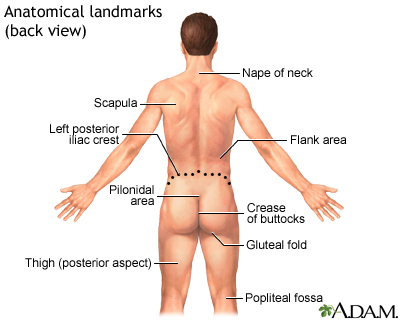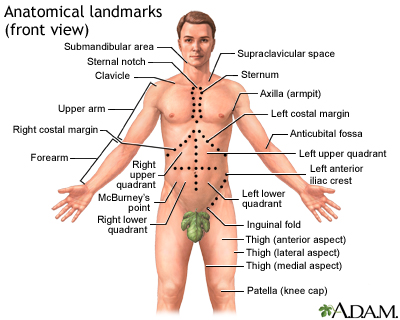Flank pain
 Print-Friendly
Print-Friendly
Pain - side; Side pain
Flank pain is pain in one side of the body between the upper belly area (abdomen) and the back.
I Would Like to Learn About:
Considerations
Flank pain can be a sign of a kidney problem. But, since many organs are in this area, other causes are possible. If you have flank pain and fever, chills, blood in the urine, or frequent or urgent urination, then a kidney problem is the likely cause. It could be a sign of kidney stones.
Causes
Flank pain may be caused by any of the following:
- Arthritis or infection of the spine
- Back problem, such as disk disease
- Gallbladder disease
- Gastrointestinal disease
- Liver disease
- Muscle spasm
- Kidney stone, infection, or abscess
- Shingles (pain with one-sided rash)
- Spinal fracture
Home Care
Treatment depends on the cause.
Rest, physical therapy, and exercise may be recommended if the pain is caused by muscle spasm. You will be taught how to do these exercises at home.
Nonsteroidal anti-inflammatory drugs (NSAIDs) and physical therapy may be prescribed for flank pain caused by spinal arthritis.
Antibiotics are used to treat most kidney infections. You will also receive fluids and pain medicine. You may need to stay in the hospital.
When to Contact a Medical Professional
Contact your health care provider if you have any of the following:
- Flank pain along with a high fever, chills, nausea, or vomiting
- Blood (red or brown color) in the urine
- Unexplained flank pain that continues
What to Expect at Your Office Visit
The provider will examine you. You will be asked about your medical history and symptoms, including:
- Location of the pain
- When the pain began, if it's always there or comes and goes, if it's getting worse
- If your pain is related to activities or bending over
- What the pain feels like, such as dull and aching or sharp
- What other symptoms you have
The following tests may be done:
- Abdominal CT scan
- Blood tests to check kidney and liver function
- Ultrasound to look at your internal organs
- Chest or abdominal x-ray
- Kidney or abdominal ultrasound
- Lumbosacral spine x-ray
- Tests to check the kidneys and bladder, such as urinalysis and urine culture, or cystourethrogram
Related Information
| FeverKidney stones | Kidney stones - In... |
References
Landry DW, Bazari H. Approach to the patient with renal disease. In: Goldman L, Schafer AI, eds. Goldman-Cecil Medicine. 26th ed. Philadelphia, PA: Elsevier; 2020:chap 106.
McQuaid KR. Approach to the patient with gastrointestinal disease. In: Goldman L, Schafer AI, eds. Goldman-Cecil Medicine. 26th ed. Philadelphia, PA: Elsevier; 2020:chap 123.
Millham FH. Acute abdominal pain. In: Feldman M, Friedman LS, Brandt LJ, eds. Sleisenger and Fordtran's Gastrointestinal and Liver Disease. 11th ed. Philadelphia, PA: Elsevier; 2021:chap 11.
Seller RH, Symons AB. Abdominal pain in adults. In: Seller RH, Symons AB, eds. Differential Diagnosis of Common Complaints. 7th ed. Philadelphia, PA: Elsevier; 2018:chap 1.














